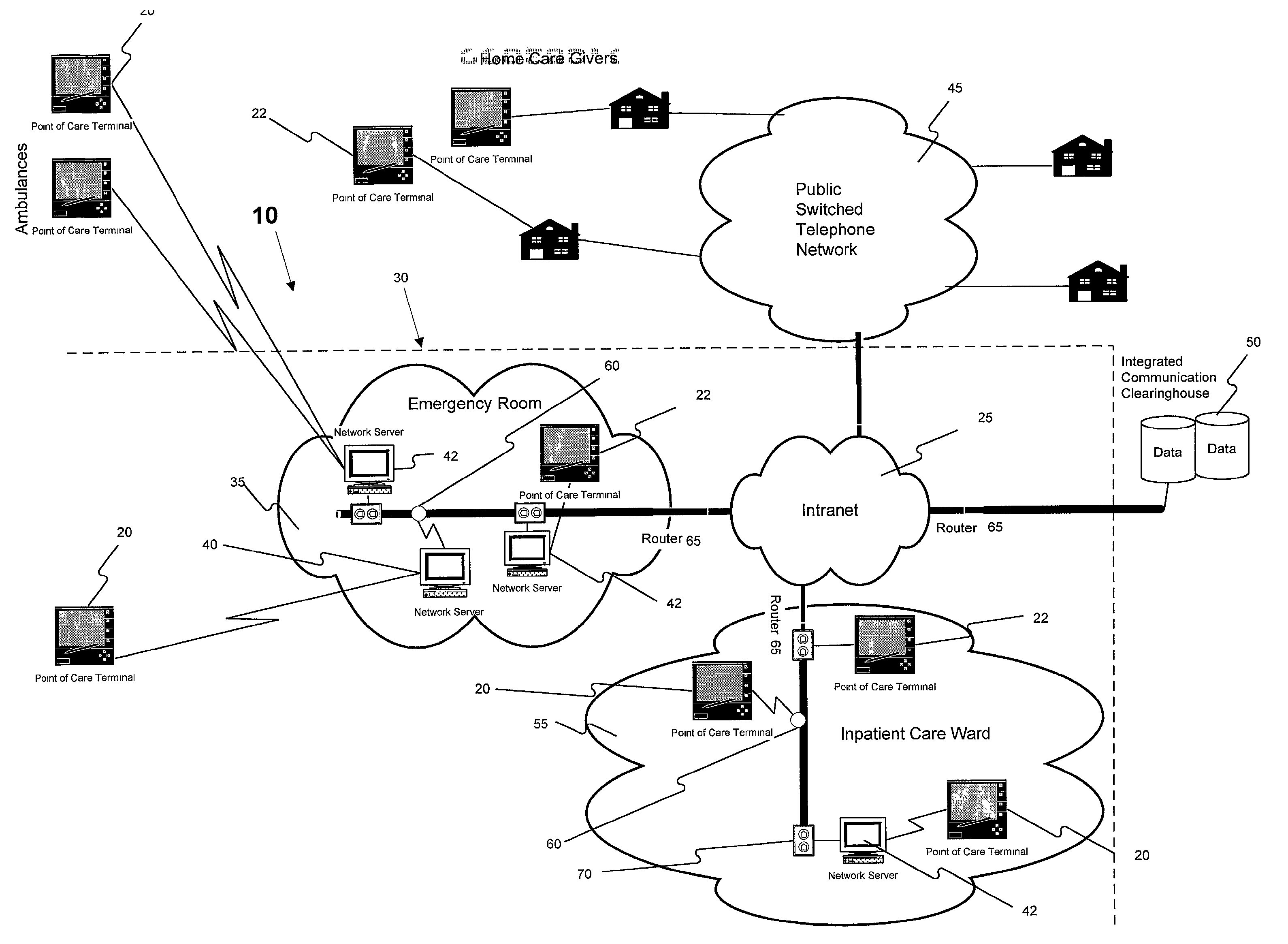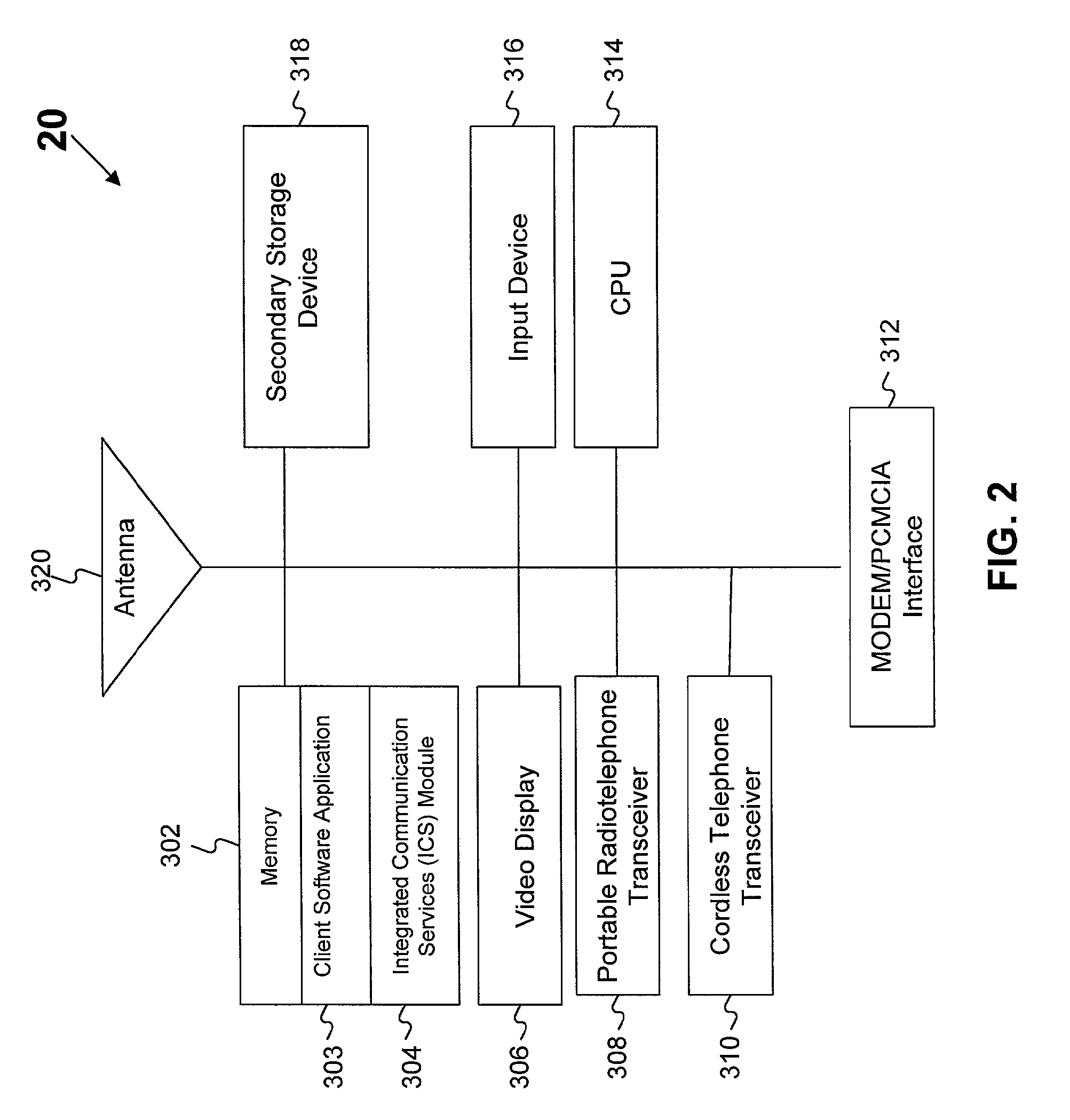[0011]Systems and methods consistent with this invention provide an integrated communication services (ICS) network that permits wireless and wireline data subscribers to share information on a hospital campus using wireless or wireline LANs, or to seamlessly tap into the facility's databases while in transit away from the hospital. The ICS network permits simplified delivery of patient records to medical professionals for the purpose of checking on the status of a patient, updating the
patient status, submitting paperwork for insurance claims, or to monitor the effectiveness and costs of various operations and drugs. The ICS network also provides for the real time capture and transmission of
patient information (e.g.,
vital signs) before and after medical incidents, and the development of a global
patient profile (GPP)
database to monitor trends and effectiveness of various medical treatments, operations and drugs.
[0012]One of the key elements of the ICS network is a
point of care terminal for accessing the network and retrieving data files. The point of care terminal resembles a
clipboard and accepts
data entry from a
stylus on an electronic pad. For specialized applications, the point of care terminal can also be configured to accept keyboard, bar-code reader, or other inputs. Information can readily be entered graphically or alphanumerically, and can be displayed graphically, in tables, or in any other user-friendly form. The point of care terminal will replace the current
clipboard and handwritten paper charts that today are manually generated and physically routed to numerous locations. The automated point of care terminal will also displace the manual
data entry system by providing a network-based data capture and retrieval capability. This terminal eliminates re-entry of data at various locations (forms no longer need to be refilled at different departments) and a
single copy of a
data file can be shared by a number of doctors, laboratories, and nurses. As such, the terminal can save many hours of time for all medical professionals, thereby increasing hospital efficiency. This time can be spent improving
patient care, expanding
nursing services, and enhancing the skills of members of the
medical profession. One of the greatest benefits of the point of care terminal is its ability to communicate with the rest of the ICS network regardless of its location, in a plurality of communication
modes. More specifically, the point of care terminal can communicate with the ICS network either via local wireless or wireline LAN, or remote wireless or wireline LAN. The point of care terminal can even operate in a standalone mode by capturing data on-site and then later uploading the data to the ICS network when circumstances permit.
[0017]On the
recipient side, if a particular network
server is configured to communicate across several different communication networks (i.e.,
wireless LAN, wired LAN, PSTN, etc.), the data is received without any knowledge of the medium of transmission or the method of communicating utilized by the point of care terminal. In other words the recipient network server receives the information without being aware of the transmitting point of care terminal's type of transport, whether a
wireless LAN, a PSTN, or cellular interface. To achieve this effect, the ICS module first determines whether the transmitting point of care terminal and the recipient network server are within the coverage area of the local
wireless LAN. If not, the ICS module determines the most efficient communication path that offers the lowest cost with minimum
delay to establish the connection. In this fashion, the recipient network server is guaranteed to get the data regardless of the type of channel(s) a transmitting point of care terminal has access to. The
system is also
usable even when it is out of any service area through data capture. In essence, a medical professional performing house calls could first download relevant
patient data from the ICC
database, travel to the location of the homebound patient, furnish home health care in the
remote area not served by wireless or wireline systems, capture observed
patient data in
system memory on the
remote computer and then update the
central database with the recorded information upon their return to the coverage area.
[0018]To share data with the
computer network, a user at a point of care terminal or network server simply transmits a
data file to the ICS network for
processing. The ICS module operating on the point of care terminal or the ICS network, scans all the available PCMCIA communication channels and selects the optimum channel to establish the connection. To accomplish this function, the ICS module interfaces with a communications profile
database to retrieve communications profile data and other interface parameters of the receiving
station. The communications profile database can be stored either on the point of care terminal or on the ICC
database server. This storage scheme reduces the number of simultaneous queries to the main database and offers additional reliability to the overall concept. Whenever communications profile data is changed at a local
directory (network server), the change will automatically be reported back to the main database and then on to a point of care terminal (if necessary) in order to maintain
data integrity.
 Login to View More
Login to View More  Login to View More
Login to View More 


